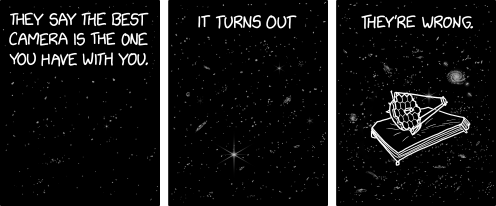2645: The Best Camera
| The Best Camera |
 Title text: The best camera is the one at L2. |
Explanation
| This explanation is incomplete: Created by an AMATEUR PHOTOGRAPHER - Please change this comment when editing this page. Do NOT delete this tag too soon. If you can address this issue, please edit the page! |
The Best Camera Is The One That's With You [1] is a book by photographer Chase Jarvis, celebrating mobile phone cameras, not for their photographic or technical quality but rather for the fact that you always have it when an interesting subject appears. This is advice often given to novice photographers, sometimes with the slight change "The best camera is the one you use most." A cheap Nikon Coolpix camera can be better than a professional Canon EOS, simply for the fact it is lightweight enough to be taken on every voyage you'll make. A fancy expensive camera that isn't at hand for you to use is of no value for taking pictures.
However, in this case "the best camera" refers to the James Webb Space Telescope (JWST), the spacecraft depicted in the third frame. It can be considered a camera because it takes pictures, and it's the best space telescope to date in terms of aperture size and thus angular resolution.[2] The first pictures taken by the telescope were released on 11-12 July 2022, days before this comic was published.[3] The pictures from JWST show objects as they were as much as 13.1 billion years ago, which is unprecedented. The telescope has three instruments that can act as "cameras" for imaging, a fourth spectrometer-only instrument, and 41 optical filters. Because the telescope can only take infrared photographs invisible to the human eye, each of the filters has been assigned a standardized visible color to convert images for viewing. However, astronomers are encouraged to use other color schemes when using a portion of the filters' range or rendering interferometry from the NIRISS Aperture Masking Interferometer or the MIRI Coronagraph, and to convert very distant objects to their original color from redshifted infrared when possible.
The title text references Lagrange Point 2 (L2). The Lagrange Points are a set of five locations which are solutions to the restricted three-body problem, in which one of the bodies is much less massive than the other two. A low-mass body in one of these locations is able to be stationary relative to the other two bodies with very little fuel needed for trajectory corrections. In this case, the JWST orbits around the L2 point of the Earth-Sun system rather than being stationed exactly at it to avoid shadows from the Earth and Moon that would cause harmful temperature and power variations.[4] It avoids the problem the Hubble Space Telescope had orbiting the Earth, allowing only a short observation window per orbit. The HST could be used for about 55 minutes of every 95-minute orbit for targets not sufficiently above or below the orbital plane.
Transcript
| This transcript is incomplete: Do NOT delete this tag too soon.. If you can address this issue, please edit the page! |
- [Each panel features an image of space, with text printed in white at the top of each panel. The first panel says:]
- They say the best camera is the one you have with you.
- [A panel showing more stars and galaxies visible.]
- It turns out
- [A panel showing even more stars and galaxies visible. At the center of the panel is an outline drawing in white of the James Webb Space Telescope.]
- they're wrong.
Discussion
Removed the part about L2 being in Earth's umbra. Although this is true, the JWST is not actually at L2; it revolves around L2, specifically to avoid being in the Earth's umbra (and the moon's) and therefore avoid changes in temperature. DKMell (talk) 17:52, 13 July 2022 (UTC)
Does anyone know whether they use SAOImageDS9 or Astropy to make full color images? Both are listed under post-pipeline tools. General instructions are in this paper but it's not a software tutorial, and it doesn't mention un-redshifting very distant objects like in Dr. Becky's video (and which they didn't do completely for the deep field because the lensed galaxies were actually red.) 172.70.206.213 05:35, 14 July 2022 (UTC)
- Can we use the published image data files to produce a SMACS 0723 image with only the far-redshifted, lensed objects? 172.70.211.36 16:01, 14 July 2022 (UTC)
- There is a tutorial at https://www.galactic-hunter.com/post/jwst-data by a guy who uses PixInsight, which unlike DS9 and Astropy is commercial (€230) but a anyone can use it free for 45 days. I think the instructions for what you want to do are at https://pixinsight.com/tutorials/PCC/index.html and the data is here for SMACS 0723.
- You can use Imviz to colorize too. 172.70.207.8 00:44, 16 July 2022 (UTC)
When discussing biosignatures of exoplanets, should we draw the distinction between ozone and water? 162.158.106.113 11:58, 14 July 2022 (UTC)
